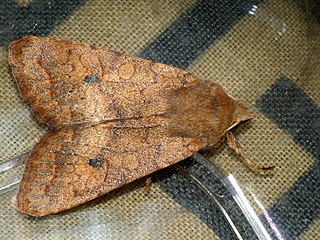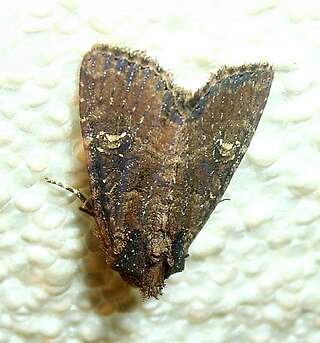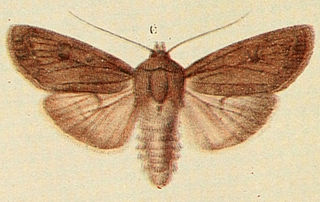
The garden dart is a moth of the family Noctuidae. It is distributed throughout much of the Palearctic. Temperate regions of Europe, Central Asia and North Asia, as well as the mountains of North Africa. Absent from polar regions, on Iceland and some Mediterranean islands, as well as in Macaronesia.

The common Quaker is a moth of the family Noctuidae first described by Johan Christian Fabricius in 1775. Some authors prefer the synonym Orthosia stabilis(Denis & Schiffermüller, 1775). It is distributed throughout Europe and is also found in Turkey, Israel, Transcaucasia, Russia and eastern Siberia.

The minor shoulder-knot is a moth of the family Noctuidae. The species was first described by Johan Christian Fabricius in 1776. It is distributed throughout Europe then east across the Palearctic to Siberia and Japan. It also occurs in Turkey.

Agrochola circellaris, or The Brick, is a species of moth of the family Noctuidae. The species was first described by Johann Siegfried Hufnagel in 1766. It is distributed throughout most of Europe, Asia Minor and Armenia.

The straw underwing is a species of moth in the family Noctuidae. The species was first described by Johann Siegfried Hufnagel in 1766. It is found from North Africa west through South Europe and Central Europe. In the north it is in parts of Ireland, Scotland, Sweden, Norway, Finland and Estonia. Further east the range stretches from southern Russia and Asia minor to the Caucasus.

Apamea crenata, known as the clouded-bordered brindle, is a moth in the family Noctuidae. It is distributed throughout the Palearctic realm. In the North it crosses the Arctic Circle, in the Mediterranean it is found only in cool locations and mountains avoiding very hot areas. In the Alps, it rises to an altitude of about 2000 metres.

Apamea remissa, the dusky brocade, is a species of moth of the family Noctuidae. It is distributed throughout Europe and Turkey, ranging across the Palearctic realm to Siberia, Manchuria and Japan. It has also been reported from Alaska.

Apamea sordens, the rustic shoulder-knot or bordered apamea, is a moth of the family Noctuidae. The species was first described by Johann Siegfried Hufnagel in 1766. It is distributed throughout Europe, east across the Palearctic to Central Asia and to China and Japan. It also occurs in North America.

Orthosia incerta, the clouded drab, is a species of moth of the family Noctuidae, found in Europe and Asia. The occurrence of the species extends through all European countries through the Palearctic to the Russian Far East and Japan. It is absent from northern Fennoscandia and in the Alps it occurs up to 2000 m above sea level.

Fissipunctia ypsillon, the dingy shears, is a species of moth of the family Noctuidae. It is found in the Palearctic realm.

Xanthia gilvago, the dusky-lemon sallow, is a moth of the family Noctuidae. The species was first described by Michael Denis and Ignaz Schiffermüller in 1775. It is found in Europe.

Catocala electa, the rosy underwing, is a moth of the family Erebidae. The species was first described by Karl Friedrich Vieweg in 1790. It can be found in Europe and Asia.

Mesapamea secalis, the common rustic, is a moth of the family Noctuidae. The species was first described by Carl Linnaeus in his 1758 10th edition of Systema Naturae. It is found in Europe, north-west Africa, Turkey and northern Iran.

Coranarta cordigera, the small dark yellow underwing, is a moth of the family Noctuidae. The species was first described by Carl Peter Thunberg in 1788. It can be found in parts of Europe, mainly in the north. In central and southern Europe it is only found in mountainous areas. In the Alps for instance, it is found up to elevations of 2,200 meters.

Agrotis vestigialis, the archer's dart, is a moth of the family Noctuidae. The species was first described by Johann Siegfried Hufnagel in 1766. It is found in most of the Palearctic realm from Ireland east, through to Russia, Siberia, the Altai mountains and the Amur region, and is also present in the Mediterranean Basin. It is absent from the north of Finland and Norway.

Apamea unanimis, the small clouded brindle, is a moth of the family Noctuidae. The species was first described by Jacob Hübner in 1813. It is native to Europe, Turkey, Azerbaijan, and western Siberia. It has been introduced in North America and can now be found in Ontario, Quebec, New Brunswick, New York, Michigan, and Wisconsin.

Agrotis trux, the crescent dart, is a moth of the family Noctuidae. The species was first described by Jacob Hübner in 1824. It has a circum-Mediterranean distribution and is found along the coasts of France, Ireland, England, southern Europe, Algeria, Syria, Iraq, Iran, southern Russia and the Arabian Peninsula. In Africa, it is found as far south as South Africa.

Apamea oblonga, the crescent striped, is a moth of the family Noctuidae. The species was first described by Adrian Hardy Haworth in 1809. It is found in northern and central Europe, east to southern Russia, Asia Minor, Armenia, Turkestan, Turkey, Iran, southern Siberia, northern Pakistan, Mongolia, China, Sakhalin and Japan

Apamea anceps, the large nutmeg, is a moth of the family Noctuidae. The species was first described by Michael Denis and Ignaz Schiffermüller in 1775.

The Scarce Arches is a moth of the family Noctuidae. It is found in central and eastern Europe and in southern Scandinavia. north Germany, Russia including the Ural Mountains, west and east Turkestan. It is not known to breed in Britain, occurring only as a migrant.




















